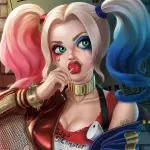In the last article, I talked about the title sequence of "Watchmen" and the details hidden in it. Today, I will continue to talk about the opening song of this film and its three components. The first part is the appearance of Minutemen, the predecessor of Watchmen. The second part is decades of changes in the times and hot social issues from Minutemen's formal establishment to its dissolution. The third part is the growth and regrouping of a new generation of Watchmen, ending with a mass movement.

The original Nite Owl is the first character to appear, with a poster of the Gotham Opera House and a cover of the "Batman & Robin" comics in the background.

Compared with the original comics, Zark spent more time describing the original Nite Owl, which could be said to be the first hero of the film version of "Watchmen."

In the original comics, the screenwriter Alan Moore used the form of Nite Owl's autobiography to add lots of background to the story. The gangster's pistol went off, giving the picture a "double expose," and the gunfire blurred Nite Owl's face.
Attention, there is a camera button sound when the new picture appears. Silk Spectre appears similarly. She cares more about media attention and pays more attention to image management. Compared with the comics, the design of the live-action version of Silk Spectre is more erotic, and the eyes of the cops in the scene are proof of that.


The third is Comedian, who is also obsessed with popularity and is more ostentatious than Silk Spectre. Whether Kid the Phantom Thie or Joker, the famous masked characters in history deliberately acted out their behaviors and formed a stage with superheroes.

Superheroes can neither lack opponents nor audiences. Silk Spectre and Comedian are the first heroes to realize this, which may also be one of the psychological reasons for their deep bond.

The first part of the opening song ends here.

Next, the B-29 bomber takes us to the end of World War II.

The kiss of victory in Times Square is recreated here, but a version of sexual orientation change, perhaps to show it with a broader mind. Meanwhile, it shows the background of "Watchmen" is not idealistic. It is not difficult to replicate the kiss, but the reactions of the people on the right after witnessing all this. They are unhappy, which foreshadows Silhouette's fate early.

Most of Minutemen's superheroes appear in the side stories of the comics, such as Dollar Bill, whose name is funny and money-oriented. Zark himself and the original comics also have some complaints about him. As a result, Dollar Bill's death is tragic and full of a clear sense of irony. Paying tribute to the famous painting "The Last Supper" is not new, but Silk Spectre will always be the most special one.

Silk Spectre's husband is standing on her left, and Captain Metropolis and Hooded Justice on her right are notable in this scene. Anyone who knows the original comics knows they are gay and have an SM relationship. This scene seems to imply the degree of intimacy between the two. Although the film does not shy away from LGBTQ elements, the two characters far away from the main narrative are naturally weakened.

Compared to many other scandals, alcoholism, and poor mental state are the biggest problems facing American public figures. Please pay attention to the newspaper clipping on the bloody bed sheet, which reads, "Minutemen member Silhouette's sex scandal exposed." And the words written in blood on the white wall remind us again. The second part of the opening song ends here.

From 8 minutes to 10 minutes, it's the era of Watchmen. The first appearance is young Rorschach. If you haven't read the comics, you may not know him. But the newspaper mentions the Soviet Union developed an atomic bomb. And the boy's facial features pave the way for the later role shaping. The second appearance is Doctor Manhattan, whose handshake with Kennedy makes him the world's focus.

The death of Kennedy in "Watchmen" is a response to the conspiracy theory of reality, and the gun used by Comedian to assassinate him is the same as in history. His intimate relationship with Nixon is secondary information in the film, such as the signature on the gun and the photo of the two.

Kennedy's death thus constitutes another conspiracy theory in the fictional timeline. Meanwhile, it also indicates that Comedian is the most involved member of Watchmen in politics. But it's not necessary that getting involved in politics, and with blood on his hands, is a villain.

Silk Spectre's quarrel with her husband is also for promoting the character's development, and the second generation of Silk Spectre's background is not just Silk Spectre's daughter. Rorschach's symbol appears for the first time, judging from the criminals' injuries, the new urban vigilante's style is fierce. It is also the only scene of violence during the Watchmen period.

It is the "Rorschach's trial" segment in the comics. The creative team did a meticulous job of understanding and dismantling the comics. They adjusted a lot of positions, added and deleted dialogues, etc. It is not a simple copy. The main line of the film is the post-Watchmen era, and their growth and fame are strung together through the details in the shots.

For example, the first shot reproduces the military parade of Brezhnev of the Soviet Union and Fidel Castro of Cuba.

The second shot reproduces a classic photograph by the famous photographer Marc Riboud.

The third shot is Andy Warhol and his Pop Art. He did arouse the enthusiasm of many filmmakers for reproduction, and Zark is one of them.
Ozymandias Veidt is one of the few Watchmen who voluntarily disclosed his identity because he found a better mask, the richest and cleverest man in the world.

As for Veidt's sexual orientation, because it is too far away from the main storyline, the film only hints at that. But in this shot, the characters in the background are standard LGBTQ images, Veidt even interacts with them, and the truth is coming out.

The relationship between Watchmen and Minutemen can be related through the old photo on the wall, which is like a group photo at the beginning, but more like a curtain call. Especially after the next shot, Nixon made new history by being elected president for the third time, which is the origin of the fictional world of "Watchmen." His election influences the psychology and actions of all the characters, including Watchmen, and strings together most of the main characters and events.

The camera continues to move, and the Doomsday Clock on the TV on the right shows a countdown of 10 minutes. The angry shouts of the masses against the vigilantes cut in, and the big letters on the window ask a question: Who watches Watchmen? At the end of the opening song, this is no longer an issue.

The final explosion scene in "Watchmen" is not radical in its lens style but conveys intense emotions. Finally, a marcher throws a Molotov cocktail at the window, causing an explosion, and the yellow special effect is transformed into the blood-stained yellow happy face at the beginning.

Not only the title sequence but also the rich details, metaphors, and Easter Eggs appear endlessly in the film, together with excellent picture composition, music, editing skills, rhythm control, role shaping, integration of historical events, and so on, which make the movie a classic masterpiece in the history of superhero movies.
What about you? Which detail in the movie impressed you the most? Tell me in the comments!







Share your thoughts!
Be the first to start the conversation.